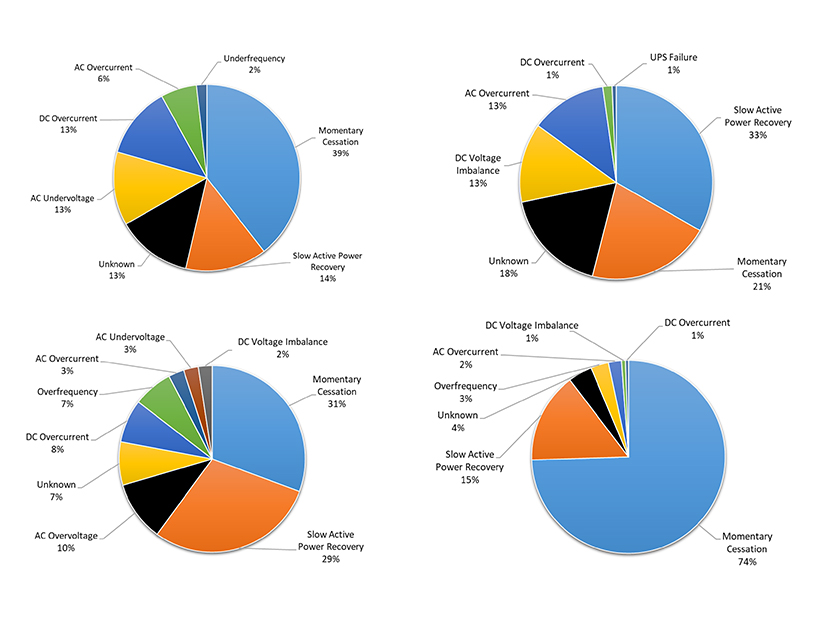
A series of disturbances involving solar resources last summer in California highlights the ongoing challenges of integrating new generation into the grid, according to a joint report by NERC and WECC released last week.
The report, “Multiple Solar PV Disturbances in CAISO,” concerns four bulk power system disturbances between June and August 2021 in Southern California that led to “widespread reductions of active power output” from solar resources. All of the events triggered the loss of at least 500 MW of generation, qualifying as a Category 1i event under NERC’s event analysis process; two also led to tripping at natural gas plants, and three caused tripping or reduction of distributed energy resources.
WECC employees have spoken about the events before: In a webinar earlier this year, WECC Reliability Initiatives Director Steve Ashbaker observed that the number of disturbances last year was the same as all those in the previous five years, indicating a significant increase in such issues. (See Texas RE, WECC Call For Coordination on DER Issues.) Other representatives from WECC warned that the accelerating pace of interconnection requests for solar projects points to a growing “reliance” on solar power in the West, making the incidents of last summer more likely.
Four Events in Three Months
NERC and WECC based the report on data from solar facilities that reduced active output by more than 10 MW during the events; the authors held follow-up discussions with plant owners and operators as needed.
In the first event, which began at 3:19 p.m. PT on June 24, a phase-to-phase fault occurred on a 500-kV line near Victorville, leading to a reduction of 765 MW across 27 solar facilities. The second, on July 4, also involved phase-to-phase faults on a 500-kV line, although this time the issue was caused by the Tumbleweed Fire and resulted in a 605-MW reduction of solar across 33 facilities. A combustion turbine at a combined cycle plant also tripped offline while loaded at 125 MW.
In the Windhub disturbance of July 28, a 500-kV line and a 500/230-kV transformer bank both tripped because of a single-line-to-ground fault that occurred while a circuit breaker that faulted was being returned to service after scheduled maintenance; as a result, CAISO recorded 511 MW of reduction across 27 solar facilities. Finally, a fire near the San Bernardino National Forest caused the Lytle Creek disturbance of Aug. 25, with 583 MW of reduction across 30 solar plants. Gas turbines at two nearby plants also tripped, carrying 303 MW of load in all.

According to the report, a “significant number of solar PV resources responded to the BPS disturbances in a manner that does not support BPS reliability.” In some cases solar facilities as far as 100 miles away from the fault locations were found to have responded abnormally.
Momentary cessation and slow active power recovery were the top two contributors to reduction and provided more than half of the drop in every case, though their shares varied widely: In the Aug. 25 event, momentary cessation accounted for almost three-fourths of the total reduction, while in the July 4 disturbance, it was only 21%. This made the July 4 event the only one in which slow active power recovery was the top cause of reductions, with 33%.
The report noted that the high degree of momentary cessation is “primarily driven from solar PV facilities with legacy inverters that cannot eliminate momentary cessation or modify settings.” Plant controllers may also have contributed to the problem, with the report suggesting their “interactions with the inverters appear to [have elongated] the expected dynamic response from these resources.”
Analysis was made more difficult by a lack of monitoring data from many plants, particularly the legacy facilities installed prior to the publication of NERC reliability guidelines related to the collection of data in BPS-connected inverter-based resources in 2019. This results in “a systemic gap in the capabilities of plant owners to analyze their facilities’ dynamic response to grid disturbances.”
Odessa Recommendations Repeated
In their recommendations, NERC and WECC emphasized that many of the issues highlighted in the report are not new: The Odessa Disturbance Report, published by NERC and Texas Reliability Entity last year, covered a widespread BPS disturbance in Texas involving a total reduction of output of more than 1,300 MW that involved solar, wind and natural gas facilities, and exposed some of the same problems. (See NERC-ERCOT Report Reviews Texas Solar Issues.)
The WECC report identified the root cause of all the issues identified in both reports as “a lack of performance requirements” in the FERC generator interconnection agreements. The report urged that FERC update the agreements to “help ensure there are no gaps in performance for newly interconnecting resources [with] clear requirements for accurate modeling and sufficiently detailed studies during time of interconnection.”
However, the report also called out NERC for shortcomings in its reliability standards that have led to “systemic issues with inverter-based resources.” To address these gaps, it said NERC’s Reliability and Security Technical Committee should help to set standards projects in motion that would result in:
- a performance validation standard to ensure that reliability coordinators and balancing authorities can seek corrective actions for plants that do not perform up to the requirements of the interconnection agreement;
- a ride-through standard to ensure solar and wind resources can endure disturbances without causing larger BPS issues;
- analysis and reporting for abnormal inverter operations; and
- inverter-specific performance requirements.


